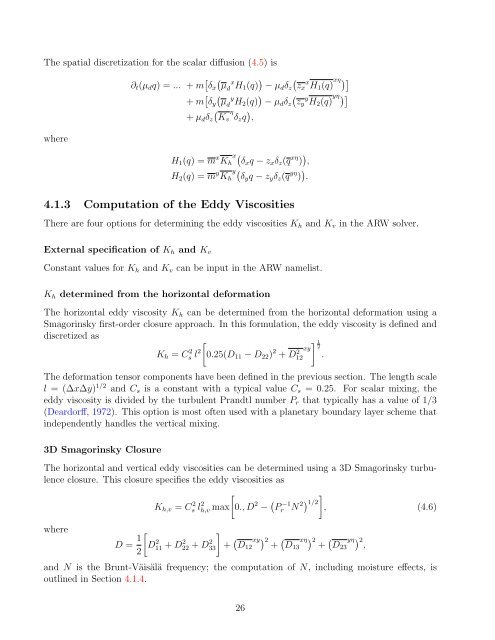Advanced Research WRF (ARW) Technical Note - MMM - University ...
Advanced Research WRF (ARW) Technical Note - MMM - University ...
Advanced Research WRF (ARW) Technical Note - MMM - University ...
Create successful ePaper yourself
Turn your PDF publications into a flip-book with our unique Google optimized e-Paper software.
The spatial discretization for the scalar diffusion (4.5) is<br />
where<br />
∂t(µdq) = ... + m x<br />
δx µd H1(q) <br />
− µdδz zx x H1(q) xη<br />
+ m y<br />
δy µd H2(q) <br />
− µdδz zy y H2(q) yη<br />
η<br />
+ µdδz Kv δzq ,<br />
H1(q) = m x x<br />
Kh δxq − zxδz(q xη ) ,<br />
H2(q) = m y y<br />
Kh δyq − zyδz(q yη ) .<br />
4.1.3 Computation of the Eddy Viscosities<br />
There are four options for determining the eddy viscosities Kh and Kv in the <strong>ARW</strong> solver.<br />
External specification of Kh and Kv<br />
Constant values for Kh and Kv can be input in the <strong>ARW</strong> namelist.<br />
Kh determined from the horizontal deformation<br />
The horizontal eddy viscosity Kh can be determined from the horizontal deformation using a<br />
Smagorinsky first-order closure approach. In this formulation, the eddy viscosity is defined and<br />
discretized as<br />
Kh = C 2 s l 2<br />
<br />
0.25(D11 − D22) 2 + D2 1<br />
xy 2<br />
12 .<br />
The deformation tensor components have been defined in the previous section. The length scale<br />
l = (∆x∆y) 1/2 and Cs is a constant with a typical value Cs = 0.25. For scalar mixing, the<br />
eddy viscosity is divided by the turbulent Prandtl number Pr that typically has a value of 1/3<br />
(Deardorff, 1972). This option is most often used with a planetary boundary layer scheme that<br />
independently handles the vertical mixing.<br />
3D Smagorinsky Closure<br />
The horizontal and vertical eddy viscosities can be determined using a 3D Smagorinsky turbulence<br />
closure. This closure specifies the eddy viscosities as<br />
Kh,v = C 2 s l 2 <br />
h,v max 0., D 2 − P −1<br />
r N 2 <br />
1/2<br />
, (4.6)<br />
where<br />
D = 1<br />
<br />
D<br />
2<br />
2 11 + D 2 22 + D 2 <br />
33 + xy2 xη2 yη2, D12 + D13 + D23<br />
and N is the Brunt-Väisälä frequency; the computation of N, including moisture effects, is<br />
outlined in Section 4.1.4.<br />
26
















